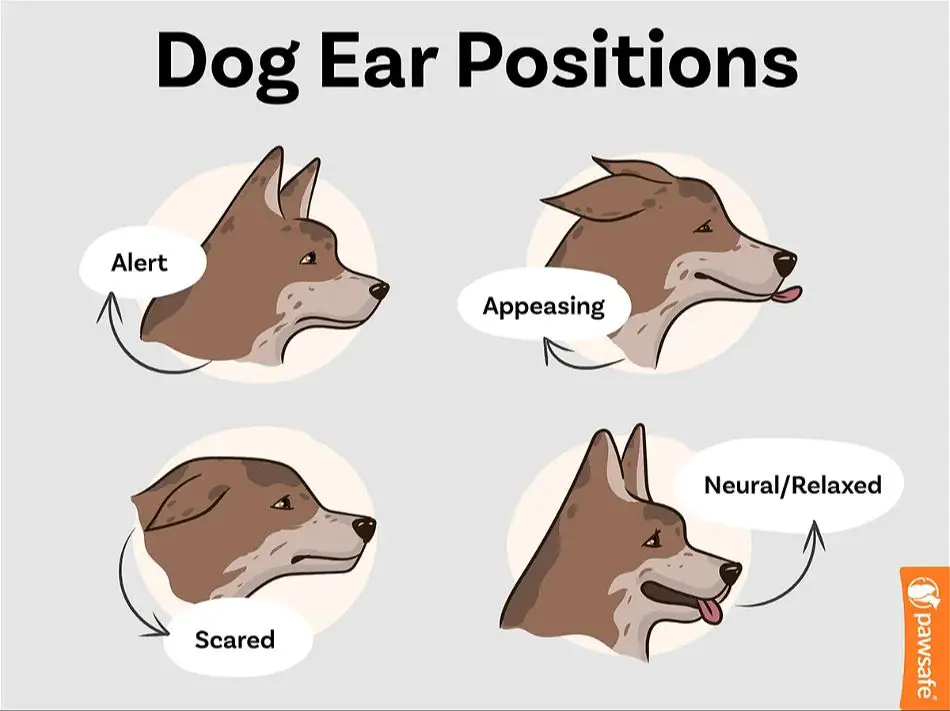What It Means When a Dog’s Ears Are Flat Against Its Head
When a dog pins its ears back against its head, it is a signal that the dog likely feels threatened or fearful in the current situation (https://dogtime.com/dog-health/general/8481-what-your-dogs-ear-position-means). Flattened ears are a sign of attempted avoidance, indicating the dog wants to disengage and withdraw. Pinned back ears are also associated with aggression or defensiveness, as part of a dog’s overall body language communicating its state of mind.
Dogs flatten their ears back against their head to make themselves appear smaller and avoid confrontation when they feel nervous or fearful. It can be one component of a cowering, crouching posture that communicates the dog’s submission and unwillingness to interact. When a dog’s ears are pinned while also showing teeth, it often means the dog is being protective and defensive due to perceived danger.
A dog’s ear position provides important context for interpreting its emotions and intentions. Flat ears indicate the dog feels threatened and hopes to avoid conflict. Along with other body language cues, flattened ears against the head signal a fearful, apprehensive, or antagonistic state of mind.
Common Causes and Triggers
There are several common reasons why a dog may flatten its ears back against its head or neck:
Loud noises like fireworks, thunder, or loud machinery can startle a dog and cause it to pin its ears back in fear or anxiety. Dogs have very sensitive hearing, so noises that seem normal to us can be overwhelming for them (1).

Unfamiliar objects, animals, or people are another trigger. When a dog encounters something new and feels unsure about it, they may flatten their ears to express skepticism or worry (2). This is especially common with strangers coming into the home.
Negative past experiences like abuse can make a dog fearful in new situations. Dogs who have been mistreated may associate things like yelling or fast movements with danger, flattening their ears in response (3).
Illness, infection, or injury that causes pain or discomfort in a dog’s ears or head is another reason their ears may press back. The pain sensations can cause them to hold their ears tightly against their head.
In summary, fear, anxiety, uncertainty, past trauma, and physical discomfort are common reasons for dogs to pin their ears back against their heads as a form of communication or natural response.
What to Do
If your dog’s ears are flat against their head, there are some steps you can take to help them feel more comfortable and relaxed:
– Remove the trigger if possible. If you can identify what is causing your dog distress, like loud noises or the presence of other animals or people, try to eliminate the trigger. For example, if the mail carrier is stressing your dog out, bring them into another room when they come to the door.
– Give the dog space and don’t force interaction. Let your dog have some alone time to decompress. Don’t approach them or try to pet them if their body language indicates they want to be left alone.
– Use calming cues like treats, toys, gentle stroking. Offer treats or a favorite toy to divert their attention and interrupt the stress response. Speak in a soft, calm voice and consider gently stroking their chest or back while avoiding direct eye contact to help them relax.

Citations:
https://www.thesprucepets.com/why-dogs-put-their-ears-back-5095445
https://www.thewildest.com/dog-behavior/ears-held-back
When to Seek Help from a Professional
While a dog pinning its ears back when stressed or frightened is quite normal, it’s important to pay attention for signs that the behavior is extreme, frequent or escalating.
Some experts note that if your dog’s ears are pinned back and flat against their head at a majority of the time with very little change, it could be a sign of a larger issue that requires intervention (https://www.thewildest.com/dog-behavior/ears-held-back). This may indicate ongoing fear, anxiety or even pain that needs to be addressed.
Additionally, if you suspect your dog’s ear positioning is connected to an underlying illness, injury or past trauma, seeking the help of a professional can be beneficial. A veterinarian can check for health problems, while a certified dog trainer or behaviorist can evaluate behavioral concerns.
It’s a good idea to consult an expert if your dog is displaying extreme submission, fear or aggression through flattened ears along with other body language signals. A professional can help get to the root of the issue and provide customized training techniques or treatment.
Training Tips
An important part of training a dog to be more comfortable when their ears go flat is through desensitization using positive reinforcement. This involves gradually exposing the dog to various stimuli in a slow, controlled way while rewarding them with treats and praise for calm behavior. The goal is to change the dog’s negative emotional response and build more positive associations. Examples of desensitization include:
- Starting with low-level audio recordings of noises like thunderstorms or fireworks at a very low volume, while rewarding the dog’s calm behavior, then slowly increasing the volume over multiple sessions.
- Exposing the dog to new environments like parks for brief periods initially, providing treats when their ears are up.
- Having a friend approach at a distance, then move closer as the dog remains relaxed.

Building the dog’s confidence is also important. Fun nosework games, obedience training, and providing new experiences in a safe, controlled way can help achieve this. Focus on creating positive experiences versus correcting the dog. With time and consistency, the dog will gain confidence and react less fearfully in situations that previously made their ears go flat.
Ear Position in Different Breeds
A dog’s natural ear type can affect how to interpret ear positions. Dogs with upright ears, like German Shepherds, usually have them pointed when alert or focused. Dogs with dropped ears, like Beagles, may naturally have ears that appear flat more often. It’s important to look at the whole body language picture, not just the ears.
For example, in an alert German Shepherd with upright ears, ears pricked forward indicate focus. But in an anxious Beagle with dropped ears, flattened ears pressed back against the head often signify fear. However, a relaxed Beagle may also have naturally flat and folded ears.
Breeds with cropped ears that stand upright have limited ear mobility. But these dogs still convey a range of emotions through ear position relative to what’s natural for the breed. The key is knowing what’s normal or expected for that individual dog.
While breed traits can help, the situation and rest of the dog’s body language provide the most insight into ear positioning. Looking at the full context allows understanding an individual dog’s unique communication style.
Body Language Signs to Look For
When a dog’s ears are flattened against its head, pay attention to other body language signs that can give clues about the dog’s emotional state:
-
Tail position – An upright, stiff tail can indicate aggression or fear. A tucked tail signals the dog is frightened or submissive.
-
Growling – Low, rumbling growls are a warning sign a dog may bite. High-pitched, rapid growling suggests fear.
-
Yawning – Frequent yawning when not tired can mean a dog is stressed or anxious.
-
Lip licking – Excessive lip licking indicates nervousness.
-
Whale eye – When you can see the whites of a dog’s eyes, it feels threatened and wants more space.
-
Tense muscles – A rigid body, furrowed brow, and clenched jaws are signs a dog is on high alert.
Paying attention to these additional body language cues along with flattened ears gives important context about a dog’s emotions and next likely actions.
When Ears Flat May Not Indicate Negative Emotion
Some dogs naturally have floppy ears that rest against their head even when they are feeling happy and relaxed. This is especially common in breeds like bloodhounds, basset hounds, cocker spaniels and labrador retrievers, among others. For these dogs, ears back is their natural ear position and doesn’t necessarily reflect their emotional state.
It’s also normal for a dog’s ears to rest against its head while sleeping or relaxing. Ears naturally fold back when a dog is calm and at ease. You may notice your dog’s ears flat when it’s napping, resting or just casually hanging out. This is no cause for concern.

Play bowing is another common trigger for ears flat. When dogs are excited to play, they often bow down with their front legs stretched forward and their hind end in the air. Their ears frequently press back against the head in this play position. It signals happy anticipation rather than negative emotions. Dogs may also pin their ears back when actively playing and roughhousing. As long as the dog’s tail is wagging and their body language is loose and wiggly, flat ears during play are completely normal.
The Importance of Reading the Situation
When a dog’s ears are flat against its head, it’s critical to consider the broader context before jumping to conclusions. The meaning behind this ear position can vary dramatically depending on the individual dog and the specifics of the situation. According to the Whole Dog Journal, “Ear position alone does not define a dog’s state of mind” (https://www.whole-dog-journal.com/behavior/dog-ear-signals/).
Get to know your dog’s unique personality and what their relaxed, happy state looks like. Be aware of what triggers stress or fear for them. Then when their ears go back, you can better understand if it signals negative emotion like anxiety or fear versus concentration or relaxation.
Look at the whole context – their full body language, what just occurred, the environment, ongoing interactions, etc. Ears back while barking aggressively at a stranger conveys a much different meaning than ears back while napping comfortably at home. Slow movements and yawning may also help indicate more relaxation. According to PetCube, “Essentially, you have to look at the entire situation to truly understand what your dog is trying to say” (https://petcube.com/blog/dog-body-language/).
Knowing your dog well and reading their overall body language will help you understand if ears flat against the head signals negative stress and fear or more positive concentration and comfort in that moment.
Providing a Safe, Positive Environment
Ensuring your dog feels safe and content in its environment is key to minimizing negative emotions that lead to flattened ears. This involves proper socialization, enrichment, exercise, and training. Meeting your dog’s basic needs for food, water, veterinary care, and safety is also important.
Socializing your dog properly from a young age teaches it how to interact appropriately with people, other animals, and new situations. Gradually expose your dog to new experiences in a calm, positive way so these don’t become stressful events later on. Arrange regular play dates with neighbor dogs you know are friendly. Reward calm, polite behavior around other dogs and people.
Provide plenty of enrichment through interactive toys, food puzzles, and changes to their environment to prevent boredom. Ensure your dog gets adequate daily exercise based on age, health status, and breed requirements. Mentally stimulating walks and play will help your dog feel relaxed.
Use reward-based training to teach manners and obedience. Set clear rules and boundaries, but never use punishment, which can create anxiety. Always reinforce wanted behaviors such as sitting politely for petting. Manage situations that trigger your dog’s stress signals like flattened ears, and help them learn to cope with stressors through gradual exposure and treats.
By meeting your dog’s fundamental needs for nutrition, shelter, medical care and safety, you enable them to be more resilient to stress. Providing a stable, caring home and lifestyle tailored to your dog’s unique needs makes for a happy, emotionally balanced companion.
With patience and compassion, you can create an enriching environment where your dog’s ears stand tall.
